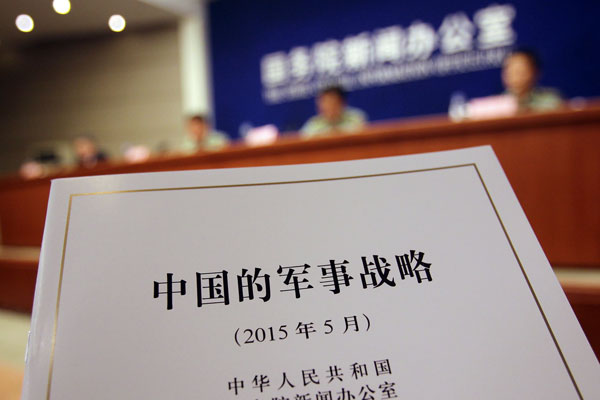
Network Warfare in China’s 2015 Defense White Paper
Publication: China Brief Volume: 15 Issue: 12
By:

The recent release of China’s biannual defense white paper (DWP) has sparked a flurry of commentary by Western People’s Liberation Army (PLA) analysts. One common theme in many of these analyses is that China is placing an increased “emphasis on cyber power” as the “newest element” of their military strategy. [1] Although it is indisputable that the PLA places a strong emphasis on information warfare and network-domain espionage, there is little basis for reading the 2015 DWP as representing a shift in Chinese policy, posture or practice on network warfare.
The Defense White Paper in Context
Before reading the tea leaves regarding the 2015 DWP’s cyber content, it’s first important to place the DWP into proper context. The DWP is a diplomatic document, not a command directive; it is best understood as a collection of ideas regarding China’s military that the Party leadership wishes to convey to foreign audiences, rather than a primary venue for disseminating new instructions from China’s political leadership into the PLA hierarchy. That does not necessarily mean these messages are deceptive; as Peter Mattis notes in his excellent new book Analyzing the Chinese Military, dismissing the DWP entirely as a mere exercise in propaganda would be a mistake, since it is often in Chinese interests to better inform and signal to outside observers their positions and intentions. However, we must be mindful, particularly when the DWP touches on sensitive matters, that its content was calculated primarily for its effect on foreign audiences rather than its accuracy as a description of the PLA’s actual activities.
As a corollary, Western PLA analysts must be incredibly careful about claiming that changes in content from one DWP to the next truly represent shifts in operational or developmental emphasis on the part of the PLA. China’s defense bureaucracy is not a monolith, and the format of the DWP has shifted somewhat from one edition to the next. While explicit revisions of previously-articulated concepts and the introduction of new ideas can certainly be meaningful, an omission or the devotion of greater space to a particular concept than in previous editions does not inherently signal an underlying change. There was an uproar from many corners, for example, when China’s no-first-use nuclear policy was omitted from the 2013 DWP, but in fact nothing had changed; a PLA Major General later clarified that it simply hadn’t fit in with the issues under discussion in that edition. [2]
The Defense White Paper and Network Warfare
Viewed through this rubric, the 2015 DWP does not appear to signal any newly increased emphasis on network warfare, but rather reflects a consistent PLA prioritization of the network domain for at least the past half-decade. The 2015 DWP’s description of outer space and cyber space as having “become new commanding heights in strategic competition” is nearly a direct word-for-word repetition of the 2011 DWP. The 2015 DWP’s description of cyberspace as a “new domain of national security” is similarly a direct repetition of both the 2013 and 2011 DWPs. The main change from previous editions is that additional space has been given to discussion of network warfare forces alongside those of other operational domains. This is in line with China’s slowly increasing comfort with publicly acknowledging the PLA’s network warfare capabilities in public forums, which has been driven in part by the eroded diplomatic position of the United States on cyber-security issues after 2013’s spate of espionage allegations.
There are several areas in which the 2015 DWP provides useful clarity on the Chinese approach to aspects of network warfare, even if the information presented is not new. First and foremost, recent DWPs reflect a consensus within the PLA—also found in the most recent edition of the Academy of Military Sciences’ Science of Military Strategy and other informative sources—that the cultivation of human capital is tremendously important for success in network warfare. The 2015 DWP calls for “expediting the development of China’s cyber force” (加快网络空间力量建设) and makes numerous references to personnel development and training for information warfare, echoing and expanding upon similar themes in prior editions. This consensus has increasingly driven the PLA’s preparations for network domain conflict, with significant investments the past several years in its network warfare-related human capital cultivation. [3]
Secondly, the 2015 DWP and its predecessors reflect the extent to which China’s development of military power in cyberspace is intertwined with the country’s civilian policy, industry and infrastructure development. The 2015 DWP references this civilian dimension by speaking of cyberspace not only as a domain of national security but also as a “pillar of economic and social development,” and explains that Chinese cyber power is designed not only to safeguard national security but also to “maintain social stability.” The 2011 DWP, similarly, speaks of information security as one of several dimensions of national security alongside political, economic, military and social security. This manner of thinking underlies China’s top-level informatization and cyber-security policies, which aim to coordinate military and civilian national development efforts in these areas rather than deal with each sphere separately. [4]
Finally, the DWPs emphasize the extent to which control of cyberspace is central to the PLA’s overarching goal of becoming a force that can “win wars under informatized conditions.” PLA leaders and theoreticians argue in the DWPs and elsewhere that game-changing new military technologies such as precision-guided munitions and unmanned weapons platforms rely on a military’s information dominance for their effectiveness. Achieving and maintaining overall information dominance, in turn, is a central military task that plays out in the outer-space, network, and electromagnetic domains.
Opportunities for Dialogue with the PLA
Although none of these points of emphasis should be particularly surprising to long-time Western observers of the PLA, there is value in having them laid out in an official document in this fashion. Western interlocutors often encounter substantial difficulties when attempting to discuss sensitive topics such as network warfare and network-enabled industrial espionage with their Chinese counterparts, largely as a result of China’s blanket refusal to acknowledge the existence of many of their programs. By issuing an official document that speaks, for example, of the “development of China’s cyber force,” the window of possible discussion may crack ever more slightly open and enable a more robust exchange of views. This expanded treatment of the topic, although not necessarily tied to any new policies, may offer an opportunity to explore several important cybersecurity and network warfare topics in bilateral discussions with the Chinese.
First and foremost, cyberspace is specifically referenced in the DWP’s section on “active defense” as a relevant security domain. When Chinese political and military leaders frequently speak of their defensive rather than offensive posture in cyberspace, it would be helpful to gain some clarity as to whether they are using term “defensive” in the sense of the “active defense” doctrine, which, as detailed by Dennis Blasko and others, encompasses a number of aggressive and pre-emptive activities that are not traditionally thought of as “defensive” by Western militaries. [5] The Chinese face a difficult balancing act here; to acknowledge that their supposedly defensive cyberspace operations are governed by the active defense principle would in some sense diminish the strength of their protest, whereas asserting that Chinese network warfare forces are governed by a more restrictive notion of defense would undermine their claim that active defense is a universal guiding principle for PLA conduct.
Recent DWPs’ repeated use of the term “cyber” in their English translations in place of the term “network” (网络) in the Chinese original also serves as an opportunity for mutual clarification. A number of Chinese authors have noted that the PLA’s concept of the “network space” (网络空间) or “network domain” (网络领域) is only a partial match for the Western concept of cyberspace. [6] Although the DWPs are somewhat notorious for their loose approach to translations of PLA terms of art into English, this could be used as an opportunity to clarify through bilateral contacts how the PLA views Western concepts of cyberspace as aligning or conflicting with their own understandings of network warfare.
It will also be important to discuss with the Chinese whether the phrase “expediting the development of China’s cyber force” encompasses the creation (or at least the public unveiling) of a PLA cyber command. Such an entity would serve an important role in the interactions of foreign militaries with the PLA, giving commands such as the United States military’s CYBERCOM a clear counterpart with which to engage. The lack of such an entity has given rise to inaccurate reporting in the Western media at times, such as when the founding of the PLA’s Information Assurance Base (信息保障基地) was inaccurately described as the launch of a “cyber command” organization.
Taken together, the Defense White Paper’s cyber-related contents fit well with its intended purpose, communicating the Chinese Communist Party (CCP) leadership’s desired messages regarding their views of China’s pressing national security concerns and providing a template for conversations with foreign interlocutors within the PLA’s ongoing military-to-military relationships. However, the undue weight given by some Western analysts to the DWP as an accurate source of information on changes in Chinese policy and intent speaks to the need for greater engagement with Chinese-language original sources by the China analysis communities of Western countries, particularly when a topic that the PLA considers sensitive and secretive—such as network warfare—is being examined. At best, placing an unequal emphasis on English-language sources can lead to distortions in our understanding of where the center of gravity lies in ongoing intra-PLA debates; at worst, it can serve as mere stenography, amplifying the PLA’s desired messaging without seriously interrogating whether the message accords with the PLA’s realities. Context matters, and at their best Western PLA watchers can play an important role in shaping the debate by enabling the non-Chinese-speaking generalist audience of policymakers and war-fighters to assess the PLA’s external messaging with greater nuance and understanding.
Notes
- See, for example, Greg Austin, “China’s Military Dream,” The Diplomat, June 2, 2015. https://thediplomat.com/2015/06/chinas-military-dream/.
- Rachel Oswald, “China’s New Defense Paper Causes Stir Over No-First-Use Nuke Policy,” Global Security Newswire, April 24, 2013. https://www.nti.org/gsn/article/chinas-new-defense-white-paper-causes-stir-over-questions-no-first-use-policy/.
- For more information, see Joe McReynolds, LeighAnn Ragland, Amy Chang, “The Human Capital Ecosystem Underlying the PLA’s Network Weapons Development,” 2014.
- See Joe McReynolds and James Mulvenon, “The Informatization of the PLA Under Hu Jintao,” in Assessing the People’s Liberation Army in the Hu Jintao Era, 2014, and Amy Chang, “Warring State: China’s Cybersecurity Strategy”, 2014.
- Dennis Blasko, “The evolution of core concepts: people’s war, active defense, offshore defense,”Assessing the People’s Liberation Army in the Hu Jintao era, Army War College Press, 2014.
- See Joe McReynolds, “Chinese Thinking on Deterrence and Compellence in the Network Domain,” CAPS-RAND PLA Conference, Taipei, 2013.





